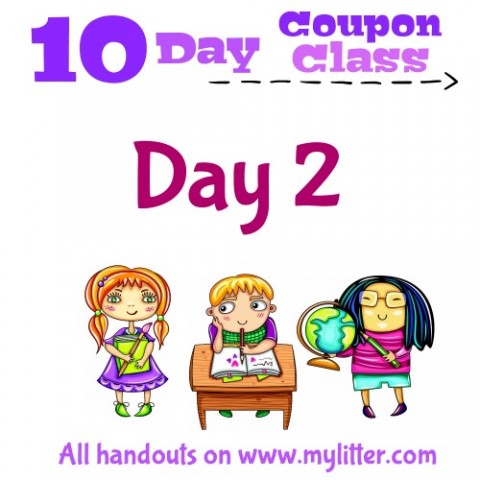 Wow! Did you get your homework done? Did you scout out where you can store your stockpile and take inventory of your coupons? Did you print off your favorite grocery stores coupon policy? GOOD!
Wow! Did you get your homework done? Did you scout out where you can store your stockpile and take inventory of your coupons? Did you print off your favorite grocery stores coupon policy? GOOD!
Hang on, because today is going to be BIG! We are going to be talking about coupons themselves, and it is going to be packed full of info! If you need to go back and see yesterdays class, you can GO HERE.
Also, if you want to PRINT this post to have as your notes, go to the bottom of the post and click “Print Post” which will allow you to have a copy!
 Today is going to be packed full like I said about all the things you have ever wanted to know about coupons, when and where to use them and how to read them and so much more.
Today is going to be packed full like I said about all the things you have ever wanted to know about coupons, when and where to use them and how to read them and so much more.
Please feel free to ask questions in the comments and we will get them answered. Remember that GOOGLE is also your BEST FRIEND. I will quickly tell you that when I first started there wasn’t Instagram and Facebook groups to help you get going. I had to GOOGLE EVERYTHING. I also had to ask TONS of questions at my store and find a friend to coupon with. The more questions you ask and research you do on your own the more successful couponer you will be!
If you are looking for some Facebook Groups to join, these are my favorite:
MyLitter Best Deals – www.facebook.com/groups/465935533435709/
MyLitter Blog Main Page – Facebook.com/mylittercom
I Heart The Mart – www.facebook.com/iheartthemart
Couponing at Kroger – www.facebook.com/groups/547075112024360/
Houston Extreme Couponing – says Houston but it is for anyone!) www.facebook.com/groups/670878056301605/
Coupon at Walmart – www.facebook.com/groups/677685802324495/
The WORDING on a coupon is MOST important. You can almost completely ignore the picture. READ What the coupons says, you go by what the coupons SAYS not what the picture is. Dole can not possibly put a picture of every canned item they make on a coupon, so if it says “any canned fruit” it means ANY canned fruit even if there is only a picture of pineapple on the front.
You can use 1 manufacturer coupon per item you are purchasing.
Types of coupon – The Most popular coupons you will see are manufacturer coupons. These are found in the Sunday coupon inserts you get in your Sunday paper, they are found in magazines, on and in cereal boxes, in the grocery stores, just about everywhere! You will know it is a manufacturer coupon because IT SAYS IT AT THE TOP!
This means the manufacturer has out this coupon out as part of a marketing campaign. They want you to use the coupon, to love their product and to buy the product again and again even without a coupon. Who does that?! 🙂 All manufacturer coupons, will say “manufacturer coupon” or some abbreviation of “manufacturer” somewhere on the coupon.
Expiration Date – About 99% of coupons will have an expiration date. Does anyone remember the old coupons with no expiration dates?? This is the date the coupon MUST be used by. Some (very few) stores will take expired coupons, you will need to ask your store.
Value of the coupon – This is the amount you will be getting off your purchase. It is how much the coupon is worth.
How many you must buy – This lets you know how many items you must purchase to get the dollar/cents amount off your purchase. If it says “2” then you need to purchase 2.
GS1 Barcode – The newer longer barcodes that were developed to help prevent coupon fraud.
Scannable Barcode – The barcode tells the store a lot of things like what you are required to purchase to use the coupon. Barcodes typically start with a 5 or a 9. If there is barcode you might have a store coupon, but you must have a readable instact barcode to use the coupon.
Retailer Terms – The retailer terms let the store know where to send this coupon to get reimbursed the full face value PLUS a $.08 – $.25 handing fee! Stores MAKE MONEY when you use a coupon.
Consumer Terms – Let’s YOU the consumer know how many items you must buy and any exclusions to the coupon.
Item Image – This is NOT what you go by when reading the coupon. This is just to help you identify what product you are looking for.
This is a lot to read. But it is YOUR JOB to understand what all is involved on a coupon and how to read it.
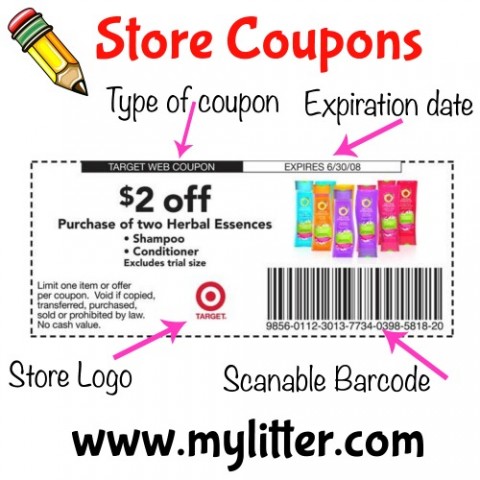 The next type of coupon we are going to be looking at is a “store coupon” You will know it is a store coupon because it will say at the top the name of the store and not manufacturer.
The next type of coupon we are going to be looking at is a “store coupon” You will know it is a store coupon because it will say at the top the name of the store and not manufacturer.
Store coupons can often be found at Target, Walgreens, CVS, Safeway stores and many more.
I love store coupons because when you have a store coupon and a manufacturer coupon for the SAME product you can use 2 coupons on 1 item! This helps you create a perfect storm in couponing where you can get many really discounted items.
With store coupons the STORE is “reimbursing” the store for the coupon and not the manufacturer (in most cases) this is why you can “stack” a manufacturer coupon and a store coupon together. A store coupon will have many of the same features as a manufacturer coupon, like a barcode, expiration date, terms and conditions etc.
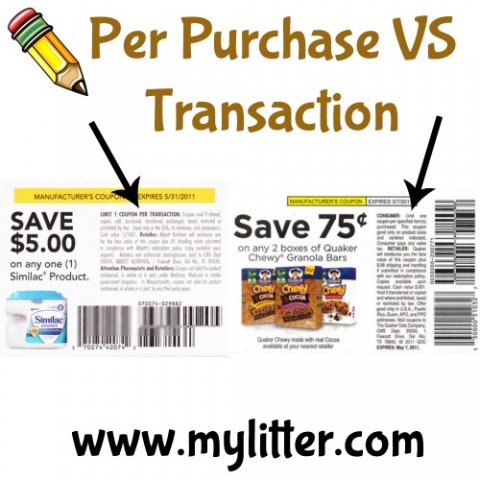 One per PURCHASE and one per TRANSACTION is one of the biggest “issues” you can run into with your cashier. A lot of well meaning cashiers, trying to do the right thing have told couponers “I am sorry, this coupon says One Per Purchase, you can only buy 1 of this item at this time….”
One per PURCHASE and one per TRANSACTION is one of the biggest “issues” you can run into with your cashier. A lot of well meaning cashiers, trying to do the right thing have told couponers “I am sorry, this coupon says One Per Purchase, you can only buy 1 of this item at this time….”
This is where YOU, as a smart and savvy couponer have the chance to explain to the cashier the difference between ONE PER PURCHASE AND ONE PER TRANSACTION.
Per Purchase: This is referring to the number of coupons that you can use on items you are PURCHASING in that transaction. If you are purchasing 4 items you must have 4 coupons to purchase them. This should NOT be confused with transaction. It also does NOT limit you to using 1 coupon in total.
Per Transaction: Or sometimes seen as “per shopping trip” refers the ENTIRE transaction or shopping trip. We can see an example of this on P&G coupons where they read, “Limit of 4 like coupons per transaction”
For example, you might purchase 20 items in a transaction, you can use 20 coupons that say “limit 1 per purchase” as you are PURCHASING 20 in that transaction. But if it says “limit 1 per transaction” you can buy as many of those items as you want in that transaction but you can only use 1 like coupon.
Make sense?
It can be confusing when you are printing and cutting out coupons to know where you can use them when you first start couponing. But quickly you will be able to see some differences and understand what they mean.
When you look at the above coupons before you print them, you can see a few differences. Mostly that 2 of them have a store logo. The top one has none. The middle coupon with the HEB logo is actually a manufacturer coupon that can be used at any store, although it has the HEB logo. The bottom coupon has a Target logo and also says “Redeem only at Target” and when you print it, it is a Target store coupon. Which can only be used at Target, and can still be combined with manufacturer coupon.
FIRST look at the top of the coupon to see if it is a manufacturer coupon or a store coupon. A manufacturer coupon can be used at ANY store as long as there as no exclusions listed on the coupon. A store logo isn’t an exclusion. UNLESS IN THE STORES COUPON POLICY THEY SPECIFICALLY SAY THEY DONT TAKE THEM. Even with another stores logo the store can still redeem it and get reimbursed for it.
The Target coupons above both say on them “Redeem Only at Target” even if these coupons are manufacturer coupons, they could only be used at Target. Because the coupons have an exclusion saying they can only be used at Target.
Now, these coupons above all have the Walmart logo on them. The logo says “Available at Walmart” basically letting you know that Walmart carries the product. Plus, they are hoping you think to yourself when seeing the logo, “I am going to use this at Walmart.”
What you need to do is read the coupon!
Finally, this is pretty much the ONLY coupon type that you can’t use at Walmart or any other store but the store it says on it. That would be a specific STORE coupon.
Clear as mud right?! It really isn’t that hard. The best thing to do is just print the coupon and read it all the way through!
Digital & Mobil coupon use is on the rise! So many sites and companies have digital coupons. Most of the time you will need to download that stores app to use the coupons. Once you have “loaded” them to your store card they can be redeemed by either scanning your store card or letting the cashier scan the barcode on your phone.
Digital coupons can be either manufacturer coupons or store coupons. Each store is different, so you will need to contact the store to find out. Digital coupons can NOT be stacked with manufacturer coupons. They can expire. You also usually can only use them 1 time. There are exceptions to this rule, again, it might depend on the store or the specific sale.
Many stores also have a mobil app where you can get coupons from and see the store sales. These are my favorite digital and mobil apps:
Safeway (Randalls) Just4U
Target mobil Coupons
Stacking coupons and doubling coupons are terms that you MUST know. You also need to know which one is which or things could get a little messy for you!
Everyone gets a little wrapped up in the doubling coupons, they thing that is the only way they can save the BIG money. While it really does help, it isn’t the only way and just because your area doesn’t double doesnt mean you can save BIG money!
Doubling Coupons – Doubling coupons only happens at stores that offer this promotion. You will need to check with YOUR local stores to see which ones participate. What typically happens is that any coupon $.39 and under will TRIPLE in face value. Coupons that are $.40 – $.50 typically double in face value. What this means is that a $.50 coupon actually should be looked at as a $1 off coupon, because the value doubled. It doesn’t mean that you are using more then 1 coupon on an item, it means the value of that coupon increased.
Stacking Coupons – This is when you use BOTH a manufacturer coupon and a store coupon on the same product. You are STACKING coupons. For example in the picture above you can see we used both a manufacturer coupon for Un-Stopables and a Store coupon for Un-Stopables getting $3 off 1 bottle!
Stacking coupons can only happen at a store that offers store coupons.
Typically stores that double coupons are higher priced stores. The “doubling” is a promotion that the store offers and the store actually pays the double amount. The brand still reimburses the store the face value of the coupon. Since so many stores are different in each area you need to call and ask your specific store their rules or look up the coupon policy online.
Thanks to Favado for the doubling and stacking coupon examples!
 Each Sunday in your Sunday paper there are “coupon inserts” typically there are 2 and they are the Smart Source or SS insert and the Red Plum or RP insert. Then 13-14 times a year we will get the P&G insert which stands for Proctor & Gamble.
Each Sunday in your Sunday paper there are “coupon inserts” typically there are 2 and they are the Smart Source or SS insert and the Red Plum or RP insert. Then 13-14 times a year we will get the P&G insert which stands for Proctor & Gamble.
There on rare occasion might also be the GM or General Mills insert and a few times a year a Target store coupon insert that is usually regional.
ALERT! on Holiday weekend there are usually NO inserts in your paper! Coupons have to take a break as well! This is a weekend I usually use to get caught up on organizing my coupons (which we will talk about tomorrow).
Located on the SKINNY spine of your insert is the date should you ever need to know what insert you are holding. This is very important when we talk about reading coupon match ups. You need to know the date the coupon came out. I usually write mine on the front of the insert when I get them and file them away.
If you are a fan of cutting out your inserts, HERE is my tutorial on what to do if you get behind.
Here is this years coupon schedule:
:: August ::
03 – RedPlum (2), SmartSource
10 – RedPlum, SmartSource
17 – RedPlum, SmartSource
24 – RedPlum, SmartSource
31 – Proctor & Gamble
:: September ::
07 – RedPlum, SmartSource (2)
14 – RedPlum, SmartSource (2)
21 – RedPlum, SmartSource
28 – RedPlum, SmartSource, Proctor & Gamble
:: October ::
05 – RedPlum, SmartSource (2)
12 – RedPlum, SmartSource
19 – SmartSource, Little Tykes
26 – RedPlum, SmartSource, Proctor & Gamble
:: November ::
02 – RedPlum, SmartSource (2)
09 – RedPlum, SmartSource
16 – RedPlum, SmartSource
23 – RedPlum, SmartSource
30 – Proctor & Gamble (Thanksgiving)
:: December ::
07 – RedPlum, SmartSource
14 – RedPlum, SmartSource
21 – No Inserts Scheduled (Christmas)
28 – Proctor & Gamble (New Year’s)
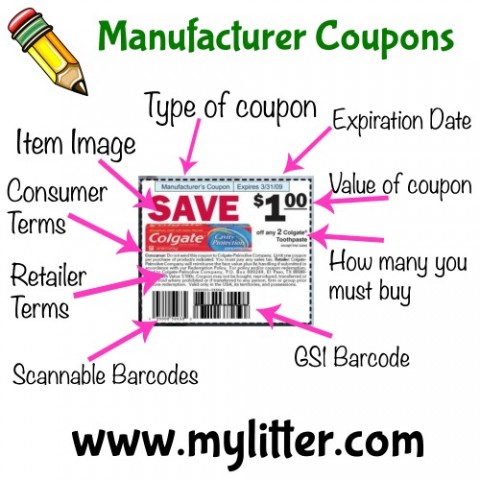
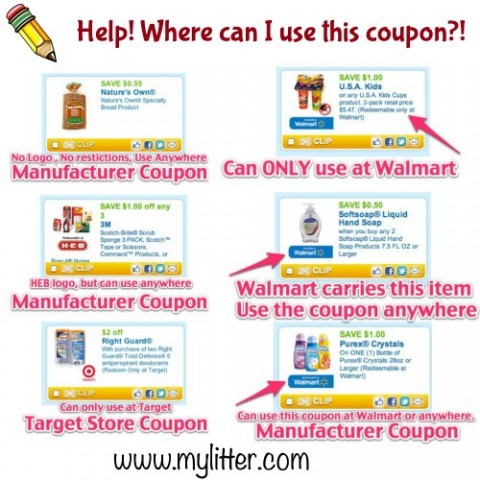
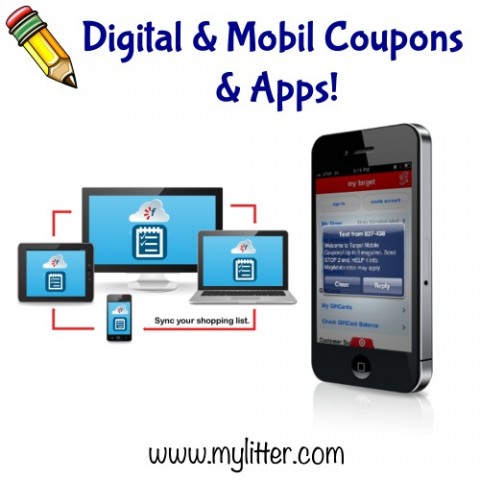
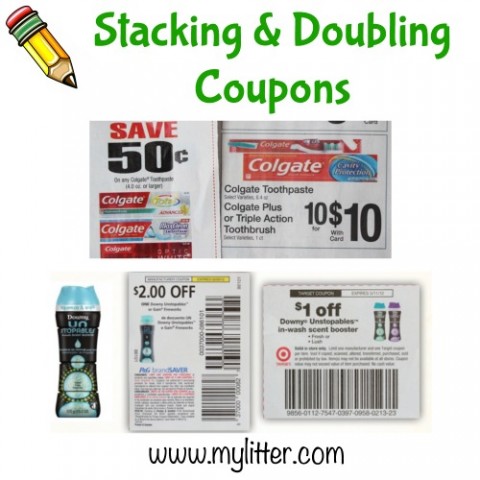


 Part comedian, part Dad, part athlete. He will boss around your children while they play ball.
Part comedian, part Dad, part athlete. He will boss around your children while they play ball. Just as angelic as she looks, this girl could easily raise a Village by herself, and all the children would grow up to be President.
Just as angelic as she looks, this girl could easily raise a Village by herself, and all the children would grow up to be President. Self proclaimed, she would be a webkinz dog. Because, "they're cute, and puppies are too. And they're sweet and they always get along with other puppies."
Self proclaimed, she would be a webkinz dog. Because, "they're cute, and puppies are too. And they're sweet and they always get along with other puppies." This mini-Martha Stewart can handle ANY craft you send her way. She isn't all bows and rainbows, she's got karate kid moves!
This mini-Martha Stewart can handle ANY craft you send her way. She isn't all bows and rainbows, she's got karate kid moves! Not "Pick-Me-Up" like caffeine, she wants you to pick her up! AND NOW!
Not "Pick-Me-Up" like caffeine, she wants you to pick her up! AND NOW! Anything that can be destroyed WILL be destroyed!
Anything that can be destroyed WILL be destroyed! Practically Perfect in Every Way for now! Nicknamed "The Panda" she is rolly polly and lives by the motto, "the little one, is KING!"
Practically Perfect in Every Way for now! Nicknamed "The Panda" she is rolly polly and lives by the motto, "the little one, is KING!" The resident Labradoodle, Miller got his name because Mom won and got to name the baby! Need something chewed up? He'll take care of it. Especially if it's expensive..
The resident Labradoodle, Miller got his name because Mom won and got to name the baby! Need something chewed up? He'll take care of it. Especially if it's expensive..